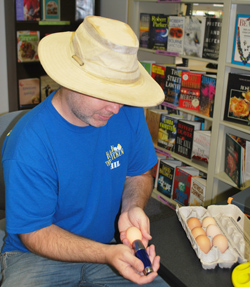Summer Library Program Features “Rent The Chicken” and More

Phillip Tompkins examines an egg that was then placed in the incubator located in the Kittanning Library. The eggs are scheduled to hatch on August 4th.
by Olivia Wasilko
The Kittanning Library’s new summer program was a hit among the children who attended yesterday.
Phillip Tompkins, founder of the Rent The Chicken program, and West Hills Primary kindergarten teacher Paul Treacy gave educational demonstrations that, among other things, explained the relation between dinosaurs and modern birds.
Tompkins, a retired information technologist, began his company “Rent the Chicken” in 2013 shortly after his wife Jenn’s contract position ended. In 2015, Tompkins gave up a twenty-year career to start the business.
“We established our company in 2013 and we’ve actually now partnered with over forty farms in the United States and Canada that do what we do with our chicken rentals as well as our hatching,” said Tompkins. “So today we have donated a hatching experience for the summer library program and what the kids will be doing is watching the development of an egg during the next twenty-one days. Then they will be hatching on August 4th.”
The Rent The Chicken program operates in South Buffalo, Pennsylvania, and services all of the country. The concept is to provide experience for those who want to harvest their own eggs without the commitment of keeping chickens long-term.
There are two six-month rental periods that cost between $400 for a standard package and $600 for a deluxe package. Each includes free delivery (within fifty miles) and setup, two to four egg-laying hens, a chicken coop, chicken feed, and all of the other supplies needed to keep chickens.
At the end of the rental period, families can adopt the chickens and their supplies or “chicken out” and return it all.
The unborn chicks that are being temporarily donated to the library will become part of the program once they are old enough to lay eggs, which will be in about six months.
In the meantime, the eggs will be displayed for children to observe under supervision. With the help of staff, the will be able to “candle” the eggs, or use a specialized flashlight to see the development inside the eggs in a way similar to an ultrasound.
“In about ten days, when they candle the egg, they’re going to be able to see the baby chick developing in here,” said Tompkins. They’re going to be able to see their hearts, their heads, their wings, their legs, all of that wonderful stuff. Then once they hatch, they’re going to keep them here for two weeks, so they can enjoy the chicks and also be able to continue to watch the development of the baby chicks. Because when they’re born, they can’t fly, but at the end of two weeks their feathers will be grown enough that the baby chicks could be able to fly a little bit.”
The experience will also encourage children to learn to care for and gently handle the animals through observing them in real life.
“We’re providing a book called ‘Where Do Chicks Come From?’ for the library so that the kids can really learn about it not only through the book, but through coming to the library and learning about the hatching process by seeing it,” Tompkins said.
Treacy, a kindergarten teacher of eighteen years, also stressed the importance of hands-on experiments in children’s education. In his career, he and his classes have raised tadpoles, butterflies, and, of course, chicks.
“By bringing living creatures in and making the room interesting and fun,” Treacy explained, “it offsets having to come in and do all of the work. They’ll have things to see and explore and investigate. I have a very centered approach. I like kids touching things and seeing things. All of that makes your room interesting and fun. Those are the things that kids remember. They don’t remember all of the worksheets that you give them.”
And he certainly didn’t fill his demonstration with worksheets. Instead, he showed his eager audience a pop-up book full of pre-historic dinosaurs and saber-toothed tigers before leading them on a dinosaur hunt around the library.
After both presentations, the children decorated cut-out dinosaur shapes with beads and feathers. While all of the elementary school students enjoyed their craft time, library volunteers assisted them.
This, Treacy believes, is the way to get children to love learning.
No Comments
No comments yet.
RSS feed for comments on this post.
Leave a comment
You must be logged in to post a comment.


